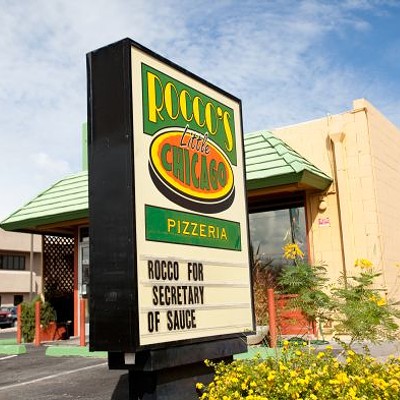Meanwhile, a dense yard in downtown's Armory Park neighborhood is overrun with feral cats. Nearby residents complain that the animals urinate on their porches and kill birds. One fellow takes it upon himself to trap the strays and haul them to the county shelter, but he ultimately catches two pets instead. Both are euthanized.
These are a sampling of conflicts occurring every day in cities across the country, as a growing pet population has led to an epidemic of strays. At the core of this problem is the fact that too many people fail to get their animals spayed and neutered. This isn't rocket science; pets reproduce exponentially.
You've likely seen the numbers, but here they are again: According to the Humane Society of the United States, a fertile cat averages three litters every year. Each litter numbers four to six kittens. By turn, an unfixed dog averages about two litters annually, with each litter numbering up to 10 puppies.
Shelters accept between 6 and 8 million companion animals each year. And each year, they euthanize up to 4 million dogs and cats.
Fortunately, groups like the Animal Welfare Alliance of Southern Arizona are determined to turn those numbers around. Founded in 2001, the group works to reduce pet overpopulation in Tucson. They've pushed for county-shelter funding, posted nearly a dozen "spay and neuter" billboards, and--with funding from the county's Pima Animal Care Center--are now offering free spay-and-neuter programs in selected neighborhoods across town.
Theirs is a common-sense approach you can't afford to ignore. At least that's how AWASA president Pat Hubbard sees it.
AWASA was begun under the notion that a coalition of animal shelters would have a better chance at corralling spay-neuter funding. Pima County Supervisor Sharon Bronson soon validated that idea, pushing to award AWASA $20,000 in contingency money. The funds "were to spay and neuter animals for people who were living in underserved communities in Pima County," says Hubbard. "We spent that, and the next year, they gave us $25,000." Eventually, the Pima Animal Care Center began raising money through its licensing program, and now gives the group $50,000 annually.
Five area clinics conduct the surgeries for AWASA. "In six weeks, they scheduled 1,034 appointments," Hubbard says. "We're going to be finishing those up in January."
That success offers a powerful take-home message, says Hubbard. "The desire among people to spay and neuter their animals is huge. I can't tell you how happy we are that the response from the community is so overwhelming."
She says it's also now clear that the cost of fixing a pet--rather than just apathy--is the biggest factor blocking people from taking that step. "Our experience has been that if you make it available, people will do it."
In 2007 alone, the group's Spay/Neuter Intervention Project, or SNIP, spayed or neutered 636 cats and dogs. Last year, the project was awarded $10,000 by the state in proceeds from special license plates called AZPetPlates, and they're soliciting funds from private interests across the community to do even more.
To raise spay-and-neuter rates, AWASA also puts out fliers, and carpets bulletin boards when clinics are planned. As a result, on the scheduled day, "We always have overflow," Hubbard says. "For anybody who didn't get served on that day, we put their name down on a list. Then one of our clinics calls and makes an appointment for them."
With that track record, Animal Care director Kim Janes expects the funding from Pima County to jump to $100,000 annually. "We're hoping that with more donations, we can increase it even further," he says, calling the spay-neuter effort "one of the keys to making animal care work. If you've got a flood going on, you've got to turn off the faucet. That's what I equate it to."
Another key is educating the public--a role that PACC takes quite seriously. "We go out to schools and libraries and communities," Janes says.
It can also reduce heartbreak at the county pound, which, according to Janes, handles 21,000 homeless animals a year. "We're able to place 8,000 a year," he says. "The math tells us that 13,000 are then euthanized. It tells us we still have a long way to go."
But it seems that path is getting clearer. Certainly, the remarkable response to AWASA shows that people will have their animals fixed if it's affordable. That premise is a mantra in the offices of Maryland-based Alley Cat Allies, a national animal-advocacy group.
"There's a certain stereotype that the problem is the 'irresponsible pet owner,'" says Allies president Becky Robinson. "But we don't believe that, and we're not the only ones who don't." She points to a study by the American Veterinary Medical Association showing that, of the 82 million cats in U.S. households, 77 to 87 percent are already spayed or neutered.
Robinson cites a spay-and-neuter effort her group undertook four years ago in Washington, D.C., that she calls a stunning--and quite telling--success. Called "Feline Frenzy," it offered very low-cost services. "We put out leaflets and knocked on doors," she says, "and we had a huge 'spay-day' where 200 household kitties came to be spayed. People lined up at 6 o'clock in the morning."
Pat Hubbard may not glimpse crowds queued at daybreak, but AWASA has seen comparable turnouts at similar events, such as one clinic focused on spaying and neutering pit bulls. "There were these big, macho guys carrying their dogs in," she says. "Even they knew that their dogs should be fixed."
Another time, AWASA borrowed a mobile veterinary clinic from Phoenix and took its services directly into local neighborhoods. People poured out for the opportunity. The importance of this work hit home, says Hubbard, when she chatted with a woman waiting her turn.
"She was this lovely Mexican woman, probably in her late 50s, holding her little Chihuahua. When I walked by, she said, 'Thank you, thank you.' Then she looked at her dog and squeezed it, and said, 'Baby, you'll never, ever have to have another litter of puppies.'"












